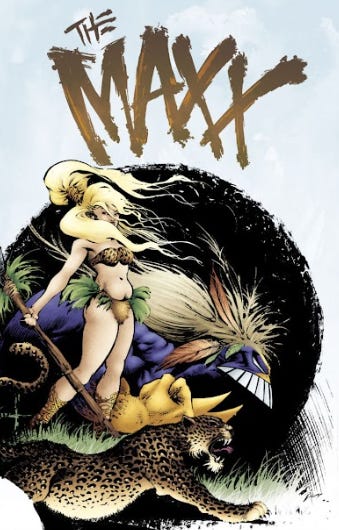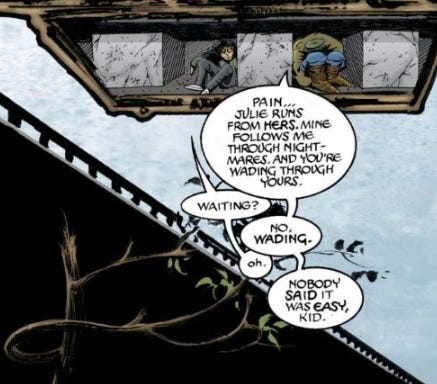It’s no surprise to me that Sam Kieth’s The Maxx and Peter Chung’s Aeon Flux were two of my favorite animated series when I was a child, and yet adult me kind of wonders if those shows were maybe too adult and violent for a kid aged 8-12.
More recently, I’ve found myself drawn back to the comic series The Maxx, not only fascinated by the gorgeous art and mysteriously unfolding story, but also curious about what captivated 8-year-old me and why this series—with themes of loneliness, violence, and separation—was so comforting to her.
Reading the series as an adult, the sadness and lack of safety each character faces are much more palpable. I can almost imagine baby me desiring the kind of protection Maxx seems to provide, or at least the protection Maxx wants to provide to Julie.
In reality, his battle is much more a battle of the self: as much as Maxx is in love with his twin soul Julie, as much as he finds himself chasing after her, wanting so desperately to save and protect her, those desires are all just distractions. His real purpose is to figure out who he is.
And when Maxx searches for these answers, he falls into a deep haze of confusion. Julie is everywhere, both a figment of his imagination and his one true love. Every inch of his life is haunted by her, a fact she seems unaware of.
Out in the real world, Julie presents as grown-up and together. Underneath, she’s dealing with a very similar battle—confused about who she is, running from her pain, and running from the love she both desires and is terrified of.
As readers, we bear witness to the messy, winding journey Maxx and Julie are on, barely aware that they seem to be energetically riding alongside each other. It’s clear they each have to confront major wounds, ones they’ve carried their whole lives. Each has to stop running. Each has to face their own demons without the help of the other.
Just as Maxx has to figure out who he is, Julie too has to stay still for long enough to face herself.
It’s interesting to think that 8-year-old me may have imagined there was a large, furry protector out there who could keep her safe. It’s only in revisiting little me’s old favorite that I see our story more clearly: maybe she and I were meant to save each other through the inner child work I’m now able to do.
In meeting her from a place of safety, I can show her that things end up okay. In showing me how we got our wounds, she can give me insight into how to heal them. Somehow, I imagine this as a question Sam Kieth may have wanted his readers to grapple with through the comics: what do we need in order to face ourselves?
What were some of your questionable or too grown-up faves from childhood? Have you revisited them as an adult? Click below to like, comment, and share.








❤️